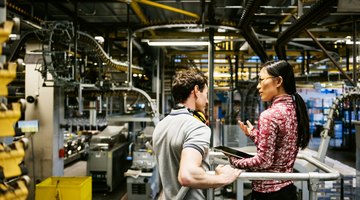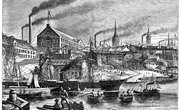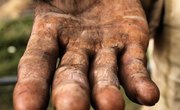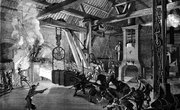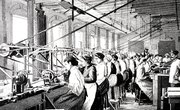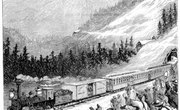In the 19th century, changes in technology and the ability to mass produce products created what is known as the Industrial Revolution, which occurred first in England and then in the United States and the rest of the Western world throughout the mid-19th and early 20th centuries. The Industrial Revolution signaled a movement from agrarian and hand-crafted products to machine-made products. This move to factory manufacturing opened up opportunities for both women and children to work outside of the home.
Negative Effects on Women
During the industrial revolution in both England and the United States, women often worked in unsafe and unsanitary working conditions, as factory work was not initially regulated by the government. Female Industrial-era workers in the United States often worked in "mill towns" such as Lowell, Massachusetts, where their lives were tightly controlled by the company and they were paid far less than men. Although most women worked in textile factories, which were less dangerous than jobs such as coal mining and other new industrial positions, even textile factories were overcrowded and unsafe. Tragedies such as the Triangle shirtwaist factory fire, in which 129 women and 17 men died, happened because of unsafe conditions and policies such as keeping outer doors locked to prevent theft.
Positive Effects on Women
Because of industrialization, many women left their homes and began to live independently. Although this caused worry for the well-being of women, it also allowed them to become a more vibrant part of social activism and labor movements that ultimately began to change dangerous working conditions. In addition, the industrial revolution allowed women to make enough money to support themselves and their families.
Negative Effects on Children
In the United States, the Industrial Revolution was somewhat driven by the use of child labor. Working caused many children to be estranged from their families and sent to workplaces in which they were considered merely a cheap source of labor. Children had to work in very dangerous conditions, performing jobs that took advantage of their small size. As a result, some developed lung diseases such as pneumonia and bronchitis in mills with poor ventilation, while others developed back problems, and some even became paralyzed, when working in coal mines.
Positive Effects on Children
There were very few benefits for children who worked during the industrial revolution: The danger, separation from family and harsh working conditions were largely detrimental for childhood development. The only children who reaped the benefits of the industrial revolution were those whose parents worked, providing the children with greater economic means for survival.
Related Articles
References
- Women in World History; Classroom Lessons Series; The Plight of Women's Work in the Early Industrial Revolution in England and Wales
- Library of Economics and Liberty; Industrial Revolution and the Standard of Living; Clark Nardinelli
- Yale-New Haven Teacher's Institute: The History of Child Labor in the United States: Hammer v. Dagenhart
- US History: Economic Growth and the Early Industrial Revolution
Writer Bio
Ann Trent has been publishing her writing since 2001. Her work has appeared in "Fence," the "Black Warrior Review" and the "Denver Quarterly." Trent received a Master of Fine Arts in creative writing from Ohio State University and has attended the Macdowell Colony. She is currently pursuing a Master of Arts in counseling.

